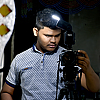
motion photography
When a camera creates an image, that image does not represent a single instant of time. Because of technological constraints or artistic requirements, the image may represent the scene over a period of time. Most often this exposure time is brief enough that the image captured by the camera appears to capture an instantaneous moment, but this is not always so, and a fast moving object or a longer exposure time may result in blurring artifacts which make this apparent. As objects in a scene move, an image of that scene must represent an integration of all positions of those objects, as well as the camera's viewpoint, over the period of exposure determined by the shutter speed. In such an image, any object moving with respect to the camera will look blurred or smeared along the direction of relative motion. This smearing may occur on an object that is moving or on a static background if the camera is moving. In a film or television image, this looks natural because the human eye behaves in much the same way.
Because the effect is caused by the relative motion between the camera, and the objects and scene, motion blur may be avoided by panning the camera to track those moving objects. In this case, even with long exposure times, the objects will appear sharper, and the background more blurred.
kirti koladiya, India, Ahmedabad